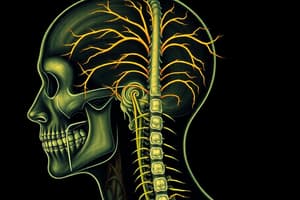Podcast
Questions and Answers
What is the primary function of a neuron?
What is the primary function of a neuron?
- To receive and integrate incoming information and transmit it to other neurons or effector organs (correct)
- To produce hormones
- To provide structural support to the nervous system
- To store information
Which part of the nervous system is responsible for the 'fight-or-flight' response?
Which part of the nervous system is responsible for the 'fight-or-flight' response?
- Cranial nerves
- Spinal cord
- Parasympathetic nervous system
- Sympathetic nervous system (correct)
Where do neurons communicate with each other?
Where do neurons communicate with each other?
- Effector organs
- Receptors
- Neuromuscular junctions
- Synapses (correct)
Which part of the nervous system is responsible for 'rest and digest' functions?
Which part of the nervous system is responsible for 'rest and digest' functions?
Which of the following is not a major part of the central nervous system?
Which of the following is not a major part of the central nervous system?
What is the primary role of sensory neurons?
What is the primary role of sensory neurons?
Which of the following is not a function of the sympathetic nervous system?
Which of the following is not a function of the sympathetic nervous system?
What is the main difference between the sympathetic and parasympathetic nervous systems?
What is the main difference between the sympathetic and parasympathetic nervous systems?
Which of the following is not a characteristic of the central nervous system?
Which of the following is not a characteristic of the central nervous system?
What is the primary function of the peripheral nervous system?
What is the primary function of the peripheral nervous system?
Study Notes
Cranial Nerves
- 12 pairs of cranial nerves, named by their function or location
- 5 pairs are motor nerves: Oculomotor N (3rd), Trochlear N (4th), Abducens N (6th), Accessory N (11th), Hypoglossal N (12th)
- 4 pairs are mixed nerves: Trigeminal N (5th), Facial N (7th), Glossopharyngeal N (9th), Vagus Nerve (10th)
- 2 pairs are sensory nerves: Vestibulocochlear N (8th)
Spinal Nerves and Nerve Plexuses
- 31 pairs of spinal nerves
- Each spinal nerve has two roots: dorsal (sensory) and ventral (motor)
- Dorsal root bears a sensory ganglion
- Spinal nerves exit from the intervertebral foramen and divide into dorsal and ventral rami
- Dorsal ramus supplies muscles and sensation to the human back
- Ventral ramus supplies antero-lateral parts of the trunk and limbs
Dermatome
- A segment of skin supplied by one spinal nerve
Protection of CNS
- Skull and vertebral column (bone)
- Meninges (membranes): three layers - Dura mater, Arachnoid mater, Pia mater
- Cerebrospinal fluid in the subarachnoid space
Brain Ventricles
- Communicating network of cavities filled with cerebrospinal fluid (CSF) and located within the brain parenchyma
- Composed of two lateral ventricles, the third ventricle, the cerebral aqueduct, and the fourth ventricle
Neurons
- Unipolar neurons: have one process emerging from the cell, receive sensory information, and are found in spinal and cranial nerve ganglia
- Bipolar neurons (rare): have two processes extending from each end of the cell body, found in olfactory epithelium, retina, and ganglia of the vestibulocochlear nerve
Nervous Tissue
- Grey matter: contains cell bodies and processes of neurons, neuroglia, and blood vessels
- White matter: contains axons of neurons, neuroglia, and blood vessels
Anatomical Planes of Brain
- Hypothetical planes used to transect the human brain to describe the location of structures or direction of movements
Brain Regions
- Cerebrum: largest part of the brain, divided into two hemispheres connected by the corpus callosum
Autonomic Nervous System
- Sympathetic Nervous System: "fight-flight-freeze" mechanism, increases blood pressure, heart rate, etc.
- Parasympathetic Nervous System: "rest and digest", decreases heart rate, blood pressure, etc.
Studying That Suits You
Use AI to generate personalized quizzes and flashcards to suit your learning preferences.
Description
Test your knowledge about the cranial nerves and spinal nerves, including their functions and classifications. Learn about the 12 pairs of cranial nerves and the 31 pairs of spinal nerves in the human body.



